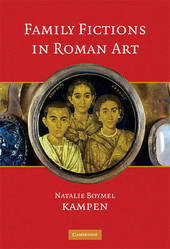
|
Family Fictions in Roman Art: Essays on the Representation of Powerful People
Hardback
Main Details
| Title |
Family Fictions in Roman Art: Essays on the Representation of Powerful People
|
| Authors and Contributors |
By (author) Natalie Boymel Kampen
|
| Physical Properties |
| Format:Hardback | | Pages:226 | | Dimensions(mm): Height 260,Width 183 |
|
| Category/Genre | Ancient and classical art BCE to c 500 CE |
|---|
| ISBN/Barcode |
9780521584470
|
| Classifications | Dewey:709.37 |
|---|
| Audience | | Undergraduate | | Postgraduate, Research & Scholarly | |
|---|
| Illustrations |
33 Plates, color; 39 Halftones, unspecified
|
|
Publishing Details |
| Publisher |
Cambridge University Press
|
| Imprint |
Cambridge University Press
|
| Publication Date |
6 April 2009 |
| Publication Country |
United Kingdom
|
Description
In Family Fictions in Roman Art, Natalie Kampen reveals the profoundly de-naturalized ways in which family could be represented in the interests of political power during the Roman Empire. Her study examines a group of splendid objects made over the course of six hundred years, from carved gems to triumphal arches to ivory plaques, and asks how and why artists and their elite patrons chose to depict family to speak of everything from gender to the nature of rulership, from social rank to relationship itself. In the process, artists found new and often strikingly odd ways to give form to families from conquered lands and provinces as well as from the Italian countryside and the court. The book's contribution is in its combination of close attention to the creativity of Roman art and interest in the visual language of social and political relationships in a great Empire.
Author Biography
Natalie Boymel Kampen is professor of Women's Studies and Barbara Novak '50 Professor of Art History at Barnard College, Columbia University. Recipient of fellowships from the National Endowments for the Humanities and the Fulbright Commission, she has been a visiting Fellow at St Hilda's College, University of Oxford and at the Cornell Society of Fellows in the Humanities. She is the author, most recently, of What is Man? Changing Images of Manliness in Late Antique Art.
Reviews"...rich analysis of how familial imagery proved at once stable and flexible, allowing Roman elites to utilize it to establish their social stability (however fictive some of those claims proved to be historically)...Certainly those interested in Roman art history would benefit from Kampen's monograph. Her conclusions about constructions of Roman family structure and self-representation, particularly as it relates to gender, however, have broader appeal. " BMCR
|